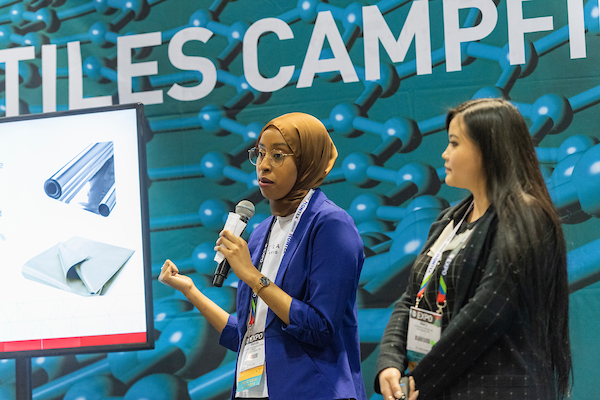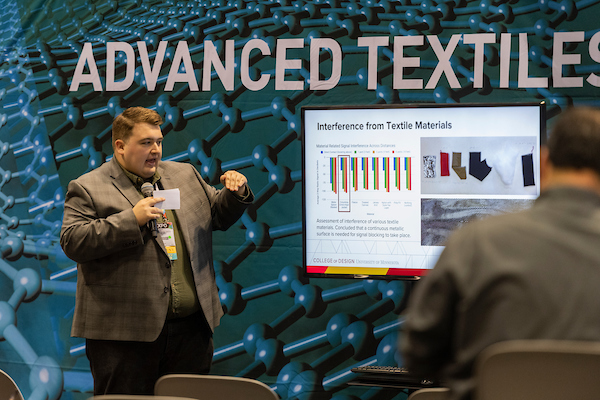Emerging Technologies Conference registration is an additional add on to Advanced Textiles Expo, Nov. 5–7.
Kick off your week at the Emerging Technologies (ET) Conference on
Tuesday, Nov. 4—an exclusive day packed with innovative education and
networking opportunities. Then, the Advanced Textiles Expo begins on
Wednesday, Nov. 5, featuring additional emerging technologies education
on the show floor and can’t-miss experiences. Expo concludes on Friday, Nov. 7.
|
Emerging Technologies Conference |
|
|
Circular Thermoregulating Textiles: Protecting Agricultural Workers from Extreme Heat
Dr. Cindy Cordoba, Assistant Professor, California State Polytechnic University, Pomona Agricultural workers face extreme heat exposure, increasing the risk of heat stress and reducing productivity. This session explores the development of thermoregulating textiles designed to enhance worker safety while incorporating circular design strategies. The presentation will highlight material selection, modular design for extended use, and system-based approaches to improve heat resilience in agricultural workwear. Attendees will gain a deeper understanding of circular strategies applied to functional apparel and their role in advancing sustainable worker protection solutions for extreme heat environments.
|
|
|
Lyocell from Hemp: A Journey from Concept to Production Reality
Lelia Lawson, Founder and CTO, Zylotex Inc This session explores the early-stage challenges and breakthroughs in scaling lyocell manufacturing using hemp as a sustainable feedstock. Drawing from real-world experience, we’ll examine the technical, logistical, and market-related hurdles that arise when introducing innovative materials into established production systems. The presentation will highlight the critical role of collaboration, persistence, and adaptive problem-solving in advancing sustainable textile solutions. Attendees will gain practical insights into the potential of hemp-based lyocell and the broader implications for the future of eco-conscious manufacturing. Learning Objectives:
|
|
|
Medical Products vs. Medical Devices
Dr. Alexander Laubach, Head of Business Development for Medical Technologies & Biocompatibility, Hohenstein Laboratories What’s the difference between a healthcare product and a medical device? How are they regulated and what claims can you make? Compliance with the EU Medical Device Regulation (MDR) and the U.S. FDA requirements for medical devices can be complicated – and avoiding medical claims on consumer products is just as important. We’ll discuss the requirements for both, focusing especially on biological safety and performance. |
|
|
Nasa’s Development of Next-Generation Lunar Space Suit Fabrics
Robert Jones, Pressure Garment Engineer, Space Suit and Crew Survival Systems Branch, NASA Johnson Space Center Learn about NASA’s development of next-generation Lunar space suit fabrics focusing on optical properties and lunar dust resistance. This session will educate the industry on space suit technology, explain technological challenges associated with space suit textile development and identify material characteristics that are most important when designing suit materials. |
|
| Panel Discussion | AI in Everyday Business: Real-World Use Cases from Industry Leaders | |
|
The Next Small Steps: Creating the Artemis Lunar Boots
Morgan Campbell, Soft Goods Developer, David Clark Company At the intersection of Design and Engineering sits Innovation: more than 50 years after the last human set foot on the Moon, a new era of space exploration, the Artemis Expeditions, carry the legacy of Apollo and the spirit of Gemini. A new group of astronauts, engineers, designers, and technicians is working to return humanity to the Moon, exploring more of its surface than ever before. These next steps will be taken wearing a pair of Axiom Space’s Lunar Boots. What does one wear while exploring the dark side of the Moon? What materials are best suited to an entirely alien environment? This presentation will explore the unique demands of lunar exploration from micrometeoroids to moon dust and the fabrics that make the mission possible. The Lunar Boot Environmental Protection Garment (EPG) is responsible for shielding and insulating the astronaut’s feet as they traverse a surface which, in some areas, has never been touched by the Sun. Beginning with the protective outer layer which provides strength, puncture resistance, and dust resistance; followed by five layers of insulating Mylar; and a lining layer that provides strength, stability, and puncture resistance; the EPG is designed to keep the astronaut comfortable and safe without compromising functionality whilst conducting Moonwalks. Each material was selected to solve a specific set of problems, culminating in a piece of soft equipment capable of withstanding an environment unlike anything found on Earth. |
|
|
Zylotex: Early Challenges in Scaling Lyocell Manufacturing with Hemp
Lelia Lawson, Founder and CTO, Zylotex Inc In this presentation, we will share the ongoing journey of Zylotex, a pioneering company in the textile industry. We will discuss the initial stages of scaling up lyocell manufacturing using hemp as a sustainable feedstock, highlighting the unique challenges we have encountered so far. This session will emphasize the importance of relationships and the drive to succeed in overcoming technical, logistical, and market-related hurdles. Attendees will gain insights into our innovative approaches and the collaborative efforts that are essential for advancing sustainable textile production. Join us to learn about the potential of hemp-based lyocell and the exciting road ahead for Zylotex. Learning Objectives
|
|
Advanced Textiles Expo 2025 includes exhibit hall space for ET innovators, suppliers, beginners and experts. Get inspired, make connections, discuss opportunities and find new products. Join over 75 vendors, associations, and ATA partners in this vibrant pavilion.
Looking for show floor education? Advanced Textiles Expo 2025 will feature interactive sessions in the Emerging Technolgies Pavilion! Stop by for fun, informal, and digestible sessions and keep the conversation flowing back to the exhibitor booths. Full show floor education schedule coming late spring 2025.



Emerging Technologies Council – ETC serves as the principal international resource providing members with the most current information on research, best practices and innovative knowledge available to advance emerging technologies within materials, products, processes and more. For more information on ETC, click here.
“Having now visited ATA shows for more than 5 years, I’d like to share with you our excitement and satisfaction during this year’s show. This year was particularly effective for us, as we had several opportunities to share our public funded research results with interested public.”
Andreas Bisinger
DITF–German Institutes of Textile and Fiber Research, Germany

Contact Us